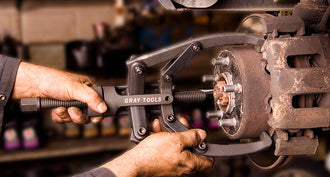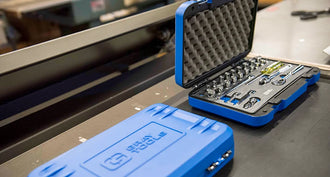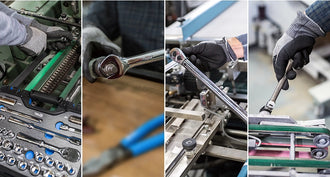Metalworking Bench Vises: A Closer Examination
- Gray Tools Official Blog
- 11 Nov, 2016

Bench vises are an integral part of any workstation whether it is fixed or mobile. The primary function of any vise is to hold an object safety and securely so that it can be worked on. Bench vises make work such as sanding, finishing, chipping, sawing, and welding easier by freeing the operator's hands to perform the needed task. Their simplicity and versatility means users of any skill level or experience can benefit from their use.
The following guide takes a closer look at the styles, components, manufacturing and key selection considerations when buying a bench vise.
Bench Vise Styles
For the purpose of this article, we will be focusing on the metalworking vise, often referred to as the Engineer's, Mechanics, Combination, or Tradesman vises. Metalworking vises are designed to be fastened to a sturdy table via eyelets located at the sides and back of the vise. The dynamic jaw (explained later) is designed to hang over the edge of the table. Although vises are primarily designed to hold a work pieces horizontally, the overhanging front jaw does permit the holding of objects vertically.
In terms of shape and design, metalworking vises can vary in many ways, as seen below:

Despite the many different types, shapes, and sizes vises most vises consist of the following major components.
Anatomy of a Bench Vise
- Sliding or Dynamic Jaw – the jaw closest to the operator that has the handle protruding through it. It is referred to as the dynamic jaw as it is the jaw that moves open and closed. The dynamic jaw applies or relieves clamping pressure.
- Fixed Body or Static Jaw – the static jaw is typically the heavier of the two jaws and, as its name implies, remains stationary during operation. The static jaw is usually fastened to the table or bench either directly or indirectly via an optional connected swivel base.
- Main or Lead screw – the component that rotates and moves the dynamic jaw open or closed. The lead screw passes through the nut and is attached to the handle. The body of the main screw is threaded. Acme is the most common thread used as its shape is easy to machine and assemble. A poorly manufactured lead screw will compromise the hold and security of any vise.
- Handle – is located at the front of the vise. It acts as the lever that turns the lead screw, which in turn moves the dynamic jaw. The handle is engineered to match the maximum clamping power the vise can handle. A properly designed and manufactured handle will bend when too much force is applied. This acts a safety indicator preventing overtorqueing. Adding a cheater bar to the handle is never recommended as personal safety will become highly compromised.
- Jaws – located at the top of each the static and dynamic jaw, the jaws essentially provide the contact points between vise and work piece. The jaws are usually made from hardened steel and machined in a serrated pattern. The pattern provides the bite needed to hold the work piece. To prevent marring of the work piece soft jaws that install over the jaws are available as add-ons. Premium quality vises have replaceable jaws.

| 1 | 2 | 3 | 4 | 5 | 6 | 7 |
| Handle and Main Screw | Pin | Serrated Jaws | Spring | Washer | Nut | Retaining Pin |
Differences in Production & Materials
Bench vises are commonly made in two distinct processes: casting and forging.
Casting is the most common and cost effective manufacturing process. It involves pouring hot liquid metal into molds. Once poured into the mold the liquid steel is allowed to cool. After cooling and hardening the molds are removed leaving a finished shape. This process is used to manufacture the static and dynamic jaws. Although cost effective, there are several drawbacks to this production method including a rough final surface finish and the possibility of impure casting and thus a weaker, compromised part.
The forging production method is more costly. However the result is a superior quality product with greater tensile strength, typically expressed in pounds per square inch (PSI ). Unlike casting, the forging process uses solid blocks of steel that are heated and then pounded into their required shape. This production method is common in the tool industry when manufacturing wrenches and pliers. A high quality forged vise can have a tensile strength of 90,000+ PSI compared to 19,000-60,000 Psi for a cast vise.
In addition to differences in production method, the materials used to make vises also differ. Two of the most common materials used are Gray (or grey) and Ductile iron. The primary difference between Gray and Ductile iron is the type and structure of the carbon present within them. The carbon type and structure provides different product characteristics, which we will examine below.
- Ductility - the addition of magnesium in ductile iron means that the graphite has a nodular/spherical shape, which results in superior strength and ductility compared to gray iron, which is shaped like flakes.
- Impact Resistance - ductile iron has a greater resistance to impacts. It is capable of resisting a minimum of 7-foot pounds of impact compared to only 2 pounds for gray iron. This can be critical if the vise has an anvil or the user frequently delivers inaccurate blows which hit the vise.
- Tensile and Yield Strength– ductile iron has a minimum tensile strength of 60,000 PSI and minimum yield strength of 40,000 PSI. Gray iron by comparison has no measurable yield strength and a tensile strength of 20,000–60,000 PSI.
Things to Consider When Purchasing a Bench Vise
As with any tool purchase, careful consideration of how the tool will be used is paramount. Before making a final decision consider the checklist list below:
|
Will you be regularly holding pipes or other cylindered objects? |
Look for a bench vises with integrated pipe jaws. These extra jaws are located in the throat of the dynamic and static jaw and are serrated and curved specifically to hold pipes. Determining the max pipe diameter is important in determining the size of vise you will need. |
|
How large are the objects you will be holding? |
Vises are typically available in 4, 5, 6 & 8" sizes. These sizes refer to the width of the jaws. The larger and heavier the object to be held the larger the vise required. As a general rule of thumb, the maximum throat depth is typically proportionate to the jaw width. |
|
Will you be holding odd shaped and sized objects? |
In some instances in order to accommodate an odd work piece a 360o swivel base is needed. If you think you will need to adjust vise position on the bench, look for a vise that offers an optional swivel base. Otherwise, consider a speciality vise such as offset or rotating model. |
|
Will be using your vise heavily every day? |
While a well manufactured vise should deliver years of reliable service some parts such as the jaws can simply wear out. If you know you will use your vise heavily plan ahead and look for a brand with replaceable serrated jaws and comprehensive spare parts support program. |
|
Will you need to hammer or shape work pieces? |
If hammering or shaping represents a significant part of your work, consider a vise with a large rear anvil. A forged model will likely also be worth the extra investment. |
|
Will you frequently remove and hold different sized work pieces? |
Look for a vise with a quick release opening system. Vises with this feature open without the need to manual unwind the lead screw. This can be a time and frustration saver. |



